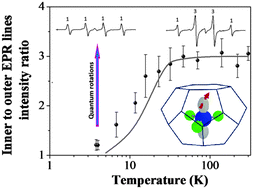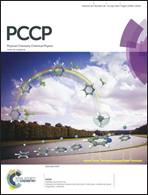Isolation of the CH3˙ rotor in a thermally stable inert matrix: first characterization of the gradual transition from classical to quantum behaviour at low temperatures
Abstract
Matrix isolation is a method which plays a key role in isolating and characterizing highly reactive molecular radicals. However, the isolation matrices, usually composed of noble gases or small diamagnetic molecules, are stable only at very low temperatures, as they begin to desegregate even above a few tens of Kelvin. Here we report on the successful isolation of CH3˙ radicals in the cages of a nearly inert clathrate–SiO2 matrix. This host is found to exhibit a comparable inertness with respect to that of most conventional noble gas matrices but it is characterized by a peculiar thermal stability. The latter property is related to the covalent nature of the host material and gives the opportunity to study the confined radicals from a few degrees of Kelvin up to at least room temperature. Thanks to this advantage we were able to explore with continuity for the first time the CH3˙ rotor properties by electron paramagnetic resonance spectroscopy, starting from the quantum rotations which are observable only at the lowest temperatures (T ≈ 4 K), going through the gradual transition to the classical motion (4 K < T < 30 K), and ending with the properties of the fully classical rotor (T > 30 K). The method of isolation presented here is found to be very effective and promising, as it is expected to be applicable to a large variety of different molecular radicals.


 Please wait while we load your content...
Please wait while we load your content...